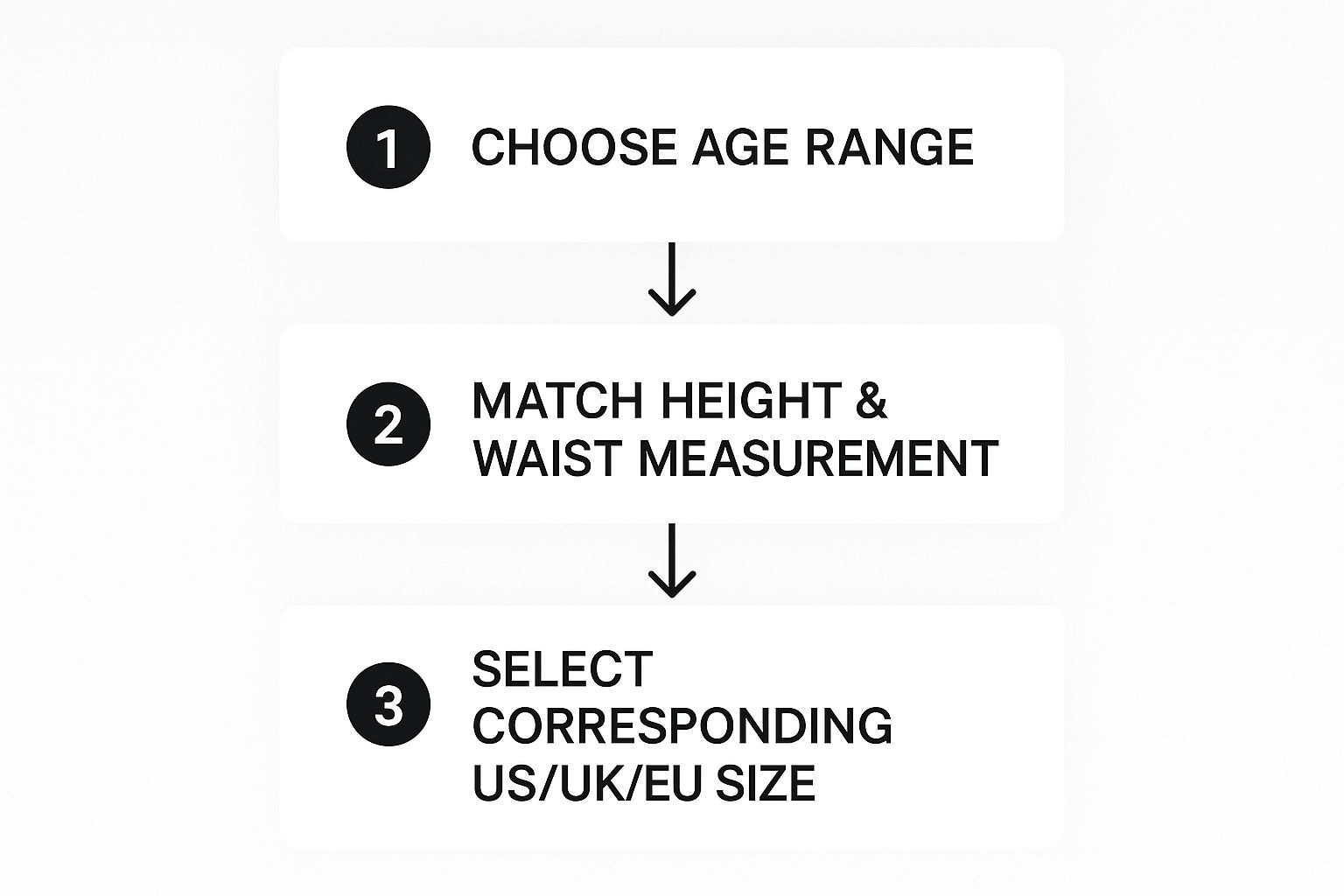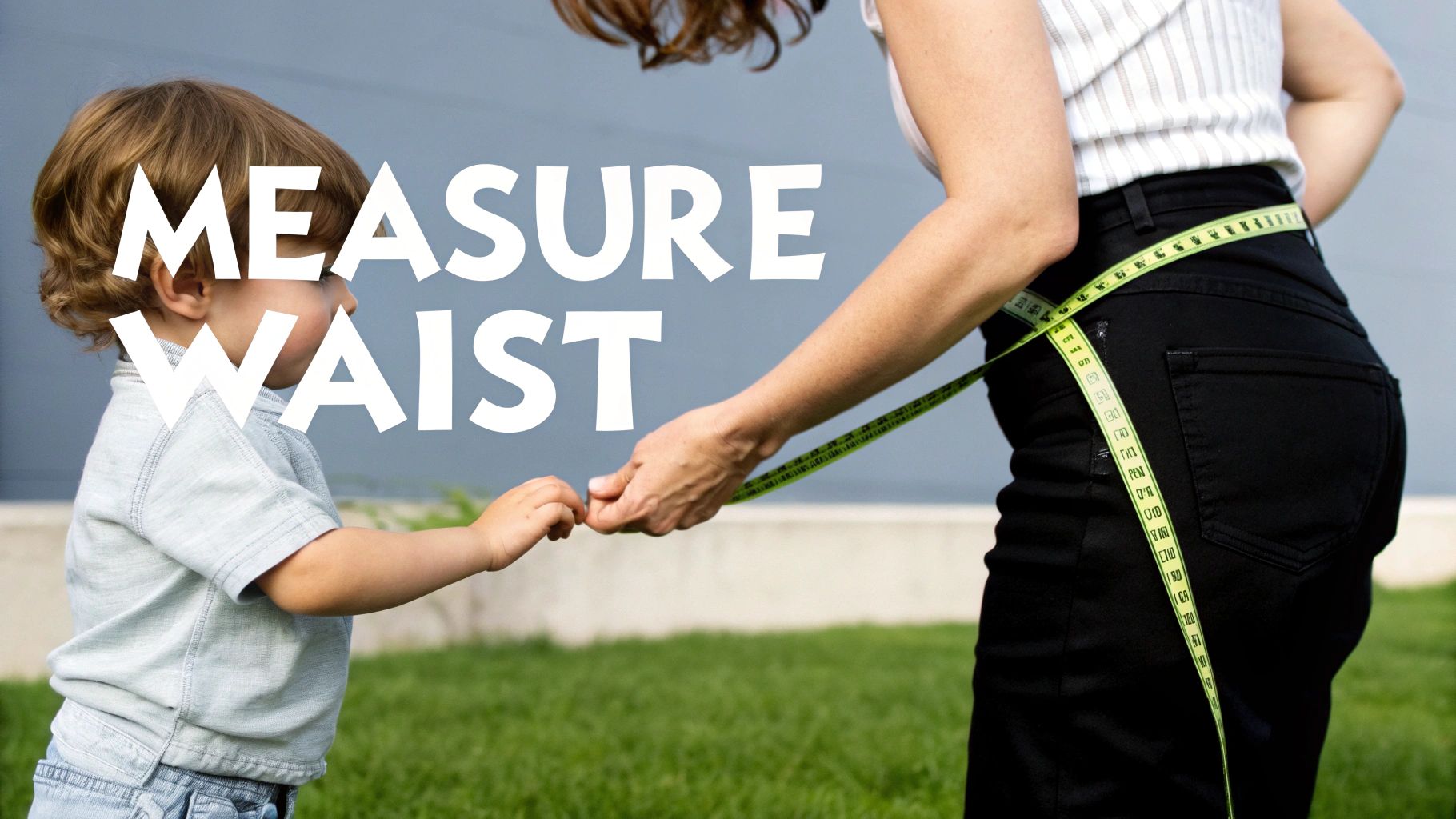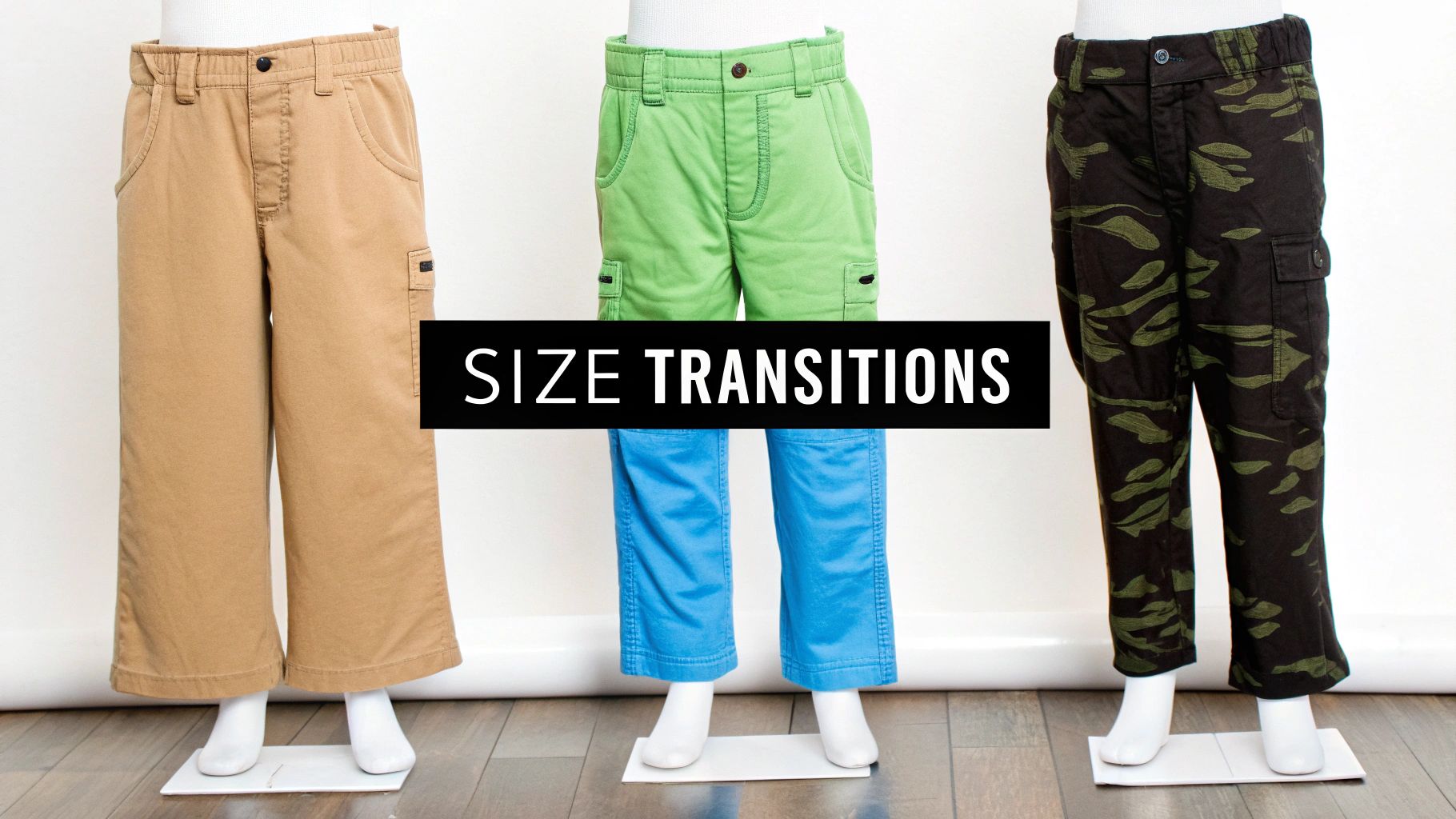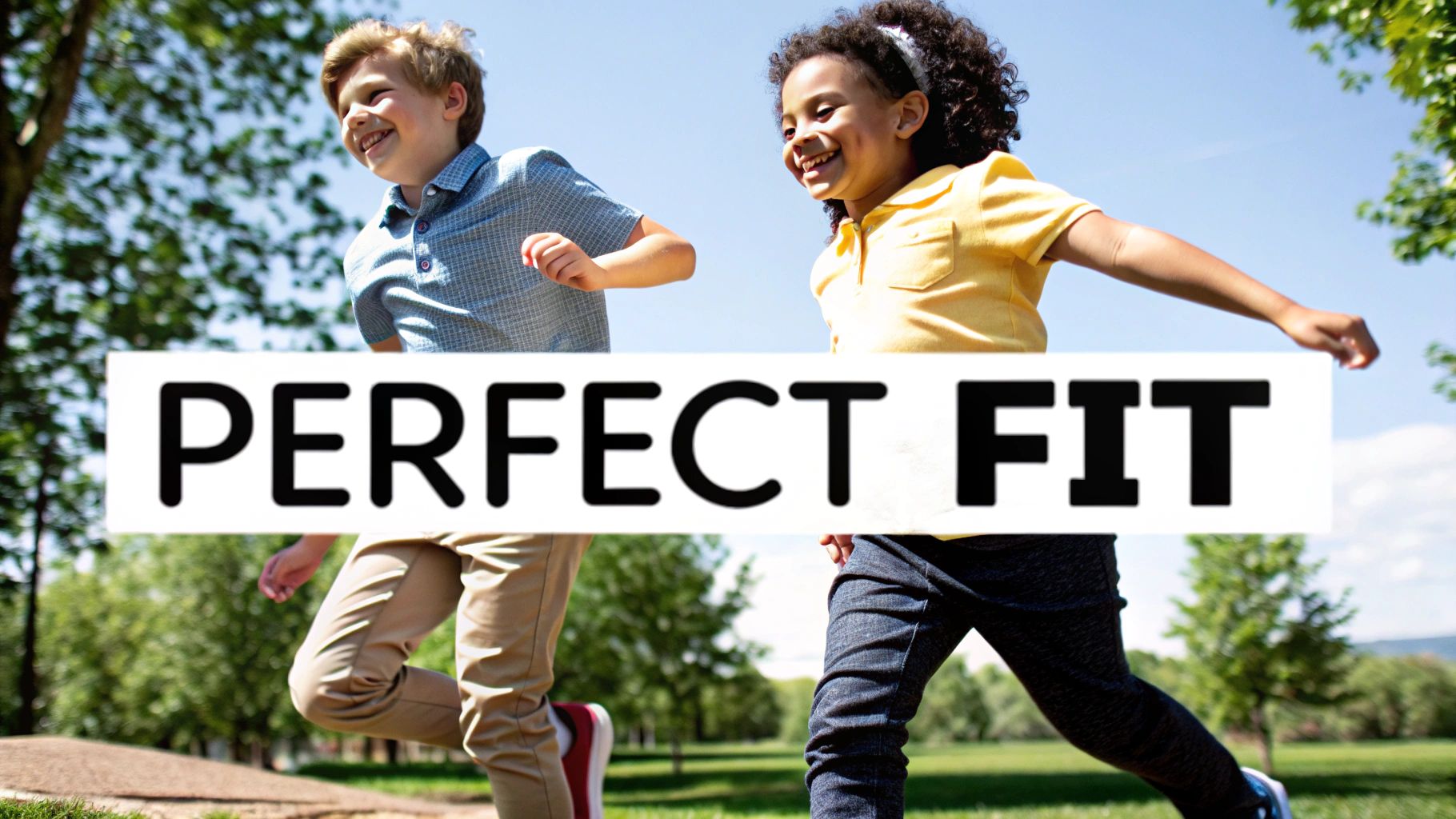A kids pants size chart is your best friend when shopping. It cross-references your child's age, height, and waist measurements to give you the correct US, UK, and European sizes. For busy parents, using a chart like this is easily the fastest way to get a reliable starting point.
Quick Kids Pants Size Chart For Every Age
Trying to find the right pants size for a growing child can feel like hitting a moving target. A good quick-reference chart takes the guesswork out of the equation.
While most people start with the child's age, remember that their height and waist measurements are much more accurate predictors of a good fit. Since different brands and countries use their own sizing systems, having a consolidated chart is crucial for shopping with confidence.
This visual guide breaks down the process into three simple steps.

As you can see, matching your child’s actual measurements to the chart is the most direct way to find the right size, no matter the international standard. Use the detailed table below as your go-to guide for quick lookups.
Comprehensive Kids Pants Size Conversion Chart
This quick reference table helps you convert kids' pants sizes for US, UK, and European standards. It also matches them with the average age, height, and waist measurements for fast lookups.
| US Size | UK Size (Age) | EU Size (Height cm) | Typical Age | Child Height (in/cm) | Waist (in/cm) |
|---|---|---|---|---|---|
| 2T | 2-3 yrs | 92-98 | 2-3 yrs | 35-38" / 89-97 cm | 20-20.5" / 51-52 cm |
| 3T | 3-4 yrs | 98-104 | 3-4 yrs | 38-41" / 97-104 cm | 20.5-21" / 52-53 cm |
| 4T | 4-5 yrs | 104-110 | 4-5 yrs | 41-44" / 104-112 cm | 21-21.5" / 53-55 cm |
| 5 | 5-6 yrs | 110-116 | 5-6 yrs | 44-47" / 112-119 cm | 21.5-22" / 55-56 cm |
| 6 | 6-7 yrs | 116-122 | 6-7 yrs | 47-49" / 119-124 cm | 22-23" / 56-58 cm |
| 7 | 7-8 yrs | 122-128 | 7-8 yrs | 49-51" / 124-130 cm | 23-23.5" / 58-60 cm |
This table provides a solid foundation, but always remember that children grow at their own pace. If your child is between sizes, it's usually best to size up to get a little more wear out of the clothes.
How to Measure Your Child for Pants
Getting the right fit for kids' pants can feel like guesswork, but taking a few quick measurements makes all the difference. While a kids pants size chart is a great starting point, nothing beats knowing your child's exact numbers. It's the surest way to get a comfortable, perfect fit every time. All you need is a flexible measuring tape and a couple of minutes.

Before you start, have your child stand up straight but relaxed. It's best if they are just in their underwear or very thin clothing so you don't get inaccurate numbers from bulky clothes. Make sure their feet are together and flat on the floor.
Key Measurements for Pants
There are really only three measurements you need to nail the perfect fit for any pair of pants: waist, inseam, and total height. Once you have these, you can confidently shop from any brand's size chart.
Here’s how to get them right:
- Waist Measurement: Find your child’s natural waistline—it's usually the narrowest spot on their torso, right around the belly button. Wrap the measuring tape around this point. You want it to be snug, but not digging in.
- Inseam Measurement: This one is all about the leg length. Start the tape at the very top of their inner thigh, right at the crotch, and measure straight down to the ankle bone. This tells you how long the pant leg should be.
- Total Height: Have your child stand with their back against a wall. Gently place a pencil flat on top of their head and make a small, light mark on the wall. Then, simply measure from that mark down to the floor.
For a deeper dive into how height translates to overall clothing sizes, our children's clothes height guide is a fantastic resource for finding the perfect fit.
Pro Tip: When you're measuring, keep the tape firm but comfortable. If it’s pulled too tight or sagging, your numbers will be off. I always recommend jotting down the measurements on your phone or a notepad so you have them ready when you're shopping.
Decoding International Kids' Sizing Systems
Shopping for kids' pants online or while traveling can be a real headache. A size 6 in the US might look totally different from its European counterpart, and that's because each region follows its own sizing logic. If you don't know what to look for, it's easy to get the wrong fit.
The key thing to remember is that while some systems are based on a child's age, others rely on specific measurements. This is exactly why having your child's current height and waist measurements handy is a game-changer, no matter where the pants are from.
Children's pants sizing can vary dramatically from one country to the next. In the United States, we’re used to age-based sizes like 2T, 3T, or 5. Hop over to Europe, though, and you'll find pants sized by a child's height in centimeters. For instance, a size 92 is made for a child who is roughly 87-92 cm tall.
The Major Sizing Philosophies
To make sense of it all, it helps to group these systems by their fundamental approach. Once you understand the core logic, you can make a much better guess just by looking at the tag.
- United States (Age-Based): US sizes like 4T or 6 are designed as general guidelines based on a child's age. The "T" you see in toddler sizes (2T-5T) just means the cut allows a little extra room for a diaper.
- Europe (Height-Based): European brands are known for their precision. They use the child's total height in centimeters as the size number (e.g., a size 110 is for a child around 110 cm tall). This is often the most reliable way to get an accurate fit.
- United Kingdom (Age-Based): The UK system is a lot like the one in the US, using age ranges like "5-6 Years". Just be aware that the actual cut and fit can sometimes be a bit different.
Once you get the hang of these systems, you can stop guessing based on age alone. Your child’s real measurements are the universal language that guarantees a great fit, no matter where in the world you're shopping.
For a complete look at how children’s clothing sizes compare globally, check out our comprehensive parents' guide to understanding childrens clothing sizes. It’s a great resource to help you shop with confidence for any brand.
Navigating kids' clothing sizes can feel like a moving target, especially as they shoot up from toddlers to big kids. Their body proportions and activity levels are constantly changing, which is why understanding the difference between Toddler, Little Kids, and Big Kids sizing is key to getting a comfortable, lasting fit.

The first major milestone is toddler sizes, which you'll see labeled as 2T to 5T. That little "T" is super important—it stands for "Toddler." These sizes are specifically designed with extra room in the rear to accommodate a diaper, and they often have a slightly shorter inseam.
Detailed Sizing by Age Group (Toddler, Little & Big Kids)
To give you a clearer picture, I've broken down the typical measurements for each age group. Remember, these are general guidelines—every child is different, so it's always best to measure!
| Size Range | Size | Typical Height (in/cm) | Typical Waist (in/cm) | Typical Inseam (in/cm) |
|---|---|---|---|---|
| Toddler | 2T | 33–35 in / 84–89 cm | 20 in / 51 cm | 13 in / 33 cm |
| 3T | 35–38 in / 89–97 cm | 20.5 in / 52 cm | 14.5 in / 37 cm | |
| 4T | 38–41 in / 97–104 cm | 21 in / 53 cm | 16 in / 41 cm | |
| 5T | 41–44 in / 104–112 cm | 21.5 in / 55 cm | 17.5 in / 44 cm | |
| Little Kids | 4 | 39–41 in / 99–104 cm | 22 in / 56 cm | 17 in / 43 cm |
| 5 | 42–44 in / 107–112 cm | 22.5 in / 57 cm | 18.5 in / 47 cm | |
| 6 | 45–46 in / 114–117 cm | 23 in / 58 cm | 20 in / 51 cm | |
| 7 | 47–48 in / 119–122 cm | 23.5 in / 60 cm | 21.5 in / 55 cm | |
| Big Kids | 8 | 49–51 in / 124–130 cm | 24 in / 61 cm | 23 in / 58 cm |
| 10 | 52–54 in / 132–137 cm | 25 in / 64 cm | 25 in / 64 cm | |
| 12 | 55–57 in / 140–145 cm | 26 in / 66 cm | 27 in / 69 cm | |
| 14 | 58–60 in / 147–152 cm | 27 in / 69 cm | 28.5 in / 72 cm | |
| 16 | 61–62 in / 155–157 cm | 28 in / 71 cm | 29.5 in / 75 cm |
These charts are a fantastic starting point for finding the right size, whether you're shopping for a newly potty-trained toddler or a growing big kid.
Toddler Sizes (2T–5T)
Toddler pants are truly built for action. The fit is intentionally looser, giving them the freedom they need to run, climb, and explore without feeling restricted.
- Key Feature: That all-important extra room in the seat for diapers.
- Proportions: Expect a shorter inseam and a more generous cut overall.
- Transition Point: Once your child is potty-trained and no longer wears diapers, you can usually transition them to the corresponding "regular" size. For example, a child moving out of a 4T would likely fit a regular size 4 or 5.
Little Kids and Big Kids Sizes (4–16+)
Once you leave the "T" sizes behind, things get a bit more streamlined. Sizing splits into "Little Kids" (usually sizes 4-7) and "Big Kids" (sizes 8 and up). The diaper-friendly cut is gone, and the pants become slimmer and longer.
This is also where you'll start to see more variety in fits. Many brands introduce "Slim" and "Husky" (or Plus) options in the Big Kids range. These specialty cuts are brilliant because they adjust the waist and hip measurements while keeping the inseam length the same as the standard size, giving you a much better chance at a perfect fit.
As they grow, it's a great time to explore different looks. Finding a good place with a solid selection of kids and girls pants can make shopping for the next growth spurt a whole lot easier.
Why Getting the Pant Fit Right Matters So Much
Let’s be honest, finding the right pant size for a growing child can feel like a moving target. But it's about so much more than just looks—it’s about their comfort, safety, and even their confidence. When pants fit just right, kids have the freedom to be kids. They can run, climb, and explore without a tight waistband digging in or bunched-up fabric getting in their way.
A good fit is also a major safety checkpoint. We’ve all seen a little one trip over pants that are just an inch too long, and it's a real hazard, especially for toddlers who are still mastering their steps. On the flip side, a waistband that's too snug isn't just uncomfortable; it can cause skin irritation. This is exactly why a reliable kids pants size chart is your best friend.

More Than Just Comfort and Safety
Don't underestimate the power of well-fitting clothes for a child's self-esteem. When they feel good in what they're wearing, it shows. They carry themselves with a little more confidence and are more ready to tackle their day at school or on the playground.
From a purely practical view, getting the size right from the start saves you the headache of returns. It's a huge focus for brands in the children's wear market, which is expected to reach an incredible USD 378.95 billion by 2030. As you can read in market reports from places like Mordor Intelligence, companies are pouring resources into accurate sizing to keep customers happy and cut down on returns. Nailing the size on your first try also means less clothing waste, making it a smarter, more sustainable choice for everyone.
Common Questions About Kids' Pants Sizes
Even with a size chart in hand, you're bound to run into some confusing labels and sizing dilemmas. It happens to all of us. Let's clear up a few of the most common questions parents ask when trying to find that perfect fit.
Think of this as your go-to FAQ for those head-scratching moments in the kids' clothing aisle.
What's the Difference Between Size 5 and 5T?
This is probably one of the most common points of confusion. The "T" in 5T stands for "toddler," and that single letter makes a big difference in the fit.
Pants in size 5T are cut with a toddler's proportions in mind, meaning they have a little extra room in the seat and hips to comfortably fit over a diaper. A regular size 5, on the other hand, is designed for a potty-trained child who typically has a slimmer, more streamlined profile.
Should I Buy a Larger Size for My Child to Grow Into?
It's tempting to buy a size up to get more wear out of clothes, but it can be a bit of a gamble. Pants that are too big can actually be a safety hazard, with long hems creating a serious tripping risk. A waistband that's too loose is just plain uncomfortable and annoying for an active kid.
If you do decide to size up, your best bet is to look for styles with adjustable waistbands. You'll also need to be ready to roll or hem the cuffs so they don't drag on the ground.
Choosing a size that fits well now is always the safest bet. It ensures your child can move freely and comfortably without the risk of tripping over excess fabric, which is especially important during active play.
What Do "Slim" and "Husky" Sizes Mean?
Slim and Husky (sometimes called Plus or Extended) are lifesavers when your child doesn't quite fit standard proportions. These are specialty sizes that adjust the waist measurement without changing the inseam or leg length.
So, if standard pants fit your child perfectly in the legs but are always too loose at the waist, look for a Slim size. If they're consistently too tight and uncomfortable around the middle, Husky sizes will give you that extra room you need.
Ready to find the perfect pair of pants for your little one? Explore the playful and comfortable collections at Yarafly, LLC, where you'll find durable styles designed for every adventure. Shop now and enjoy a perfect fit at https://yarafly.com.
Article created using Outrank